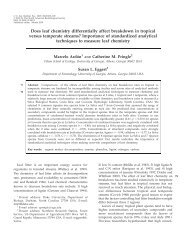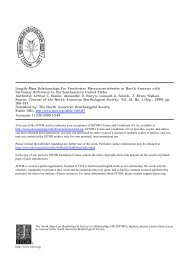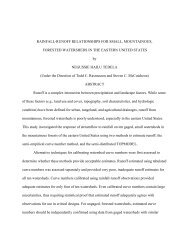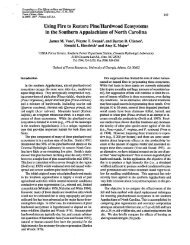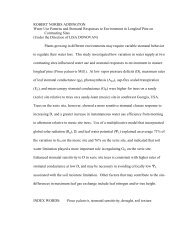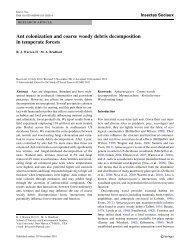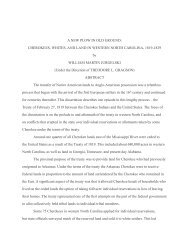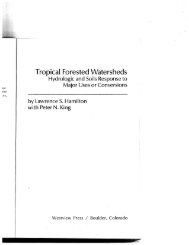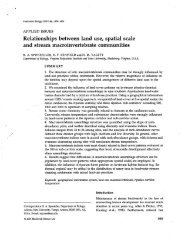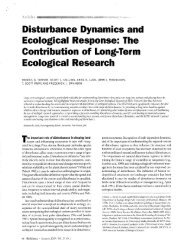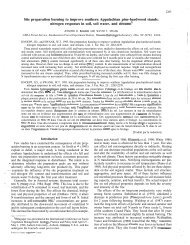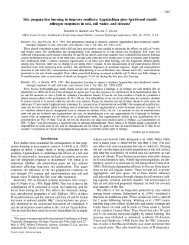biology join - Coweeta LTER - University of Georgia
biology join - Coweeta LTER - University of Georgia
biology join - Coweeta LTER - University of Georgia
Create successful ePaper yourself
Turn your PDF publications into a flip-book with our unique Google optimized e-Paper software.
Articles<br />
to properly steward or incorporate natural-resources services<br />
within urban ecosystems. Long-term research is currently<br />
being conducted in the Baltimore area to foster a better<br />
understand how urbanization affects natural system processes<br />
(e.g., Pickett and Cadenasso 2006). Baltimore, through<br />
its participation in the <strong>LTER</strong> Network, was one <strong>of</strong> the first<br />
cities to have its entire forest and tree structure assessed,<br />
along with the concomitant ecosystem services and values<br />
(e.g., pollution removal, carbon storage and sequestration,<br />
effects on building energy use; see, e.g., Nowak et al. 2008).<br />
It is also the first city (along with Syracuse, New York) to<br />
establish (in 1999) permanent vegetation-monitoring plots<br />
to assess long-term vegetation changes (Nowak et al. 2004).<br />
These data provide critical information for better understanding<br />
<strong>of</strong> urban vegetation systems, their environmental<br />
effects, and how these ecosystems are changing. These data<br />
have also helped in the development and testing <strong>of</strong> publicdomain<br />
s<strong>of</strong>tware tools designed to aid managers and the<br />
general public in assessing urban trees and their associated<br />
ecosystem services and values. Data collected in Baltimore<br />
and other cities in the mid to late 1990s led to the development<br />
<strong>of</strong> s<strong>of</strong>tware to assess urban forest structure and functions:<br />
the UFORE (urban forest effects) model (Nowak and<br />
Crane 2000). Through time, a diverse collaboration developed<br />
among numerous partners to expand the development<br />
<strong>of</strong> this and other urban forest computer programs into a<br />
suite <strong>of</strong> free s<strong>of</strong>tware tools known as i-Tree (www.itreetools.<br />
org), which was released in 2006.<br />
The information provided by i-Tree s<strong>of</strong>tware has been<br />
used to inform management and policies throughout<br />
the world in relation to urban forestry. The influence <strong>of</strong><br />
i-Tree results from the use <strong>of</strong> the model and local data<br />
by consultants, managers, and local citizens to guide<br />
management and policies decisions related to issues such<br />
as emerald ash borer protection (Siyver 2009), building<br />
financial support for urban forestry programs (Society<br />
<strong>of</strong> Municipal Arborists 2008), linking local tree data<br />
with the US Conference <strong>of</strong> Mayors Climate Protection<br />
Agreement (Hyde 2009), public outreach campaigns (e.g.,<br />
billboards) on the benefits <strong>of</strong> trees (Siyver 2009), developing<br />
urban forest strategic management plans (McNeil<br />
and Vava 2006), and helping secure financing for tree<br />
planting and management (e.g., Ibrahim 2009). Most <strong>of</strong><br />
the data collected and analyzed through i-Tree are used to<br />
encourage municipal, county, and state leaders to establish<br />
or improve urban forestry programs, to recognize<br />
the role that trees play among urban natural resources,<br />
and to focus funds to improve stewardship. New tools<br />
were released in early 2010 (version 4.0) that include new<br />
approaches to help integrate science into local policy decisions<br />
related to streamflow, tree pests, local tree cover and<br />
effects, and related ecosystem services.<br />
Information and results from i-Tree, its analyses, and<br />
impacts are generally communicated by the research partners<br />
and users to others through public presentations,<br />
reports and articles, webinars, the i-Tree Web site, and word<br />
<strong>of</strong> mouth. To assist in communicating project results, i-Tree<br />
automatically produces a standard report with graphics that<br />
users can export and customize for their own use (figure 4).<br />
Users can also report ideas, questions, or problems back to<br />
the i-Tree team, which are then used to update or develop<br />
future versions.<br />
To date, more than 8200 unique users in 99 countries have<br />
downloaded the s<strong>of</strong>tware. Use <strong>of</strong> i-Tree has grown at about<br />
30% per year since its release in August 2006. i-Tree Web site<br />
traffic has increased about tenfold since the release <strong>of</strong> version<br />
3.0 in June 2009 and continues to increase. Currently,<br />
about 20,000 unique users access the Web site every three<br />
months. Focused surveys <strong>of</strong> users have been conducted to<br />
help determine the types <strong>of</strong> impacts. Between 50 and 100<br />
journal articles and reports have been published in which<br />
i-Tree was used, and the numbers have increased annually.<br />
New programs in development are focused on temporal and<br />
spatial modeling <strong>of</strong> forest effects, and the Baltimore longterm<br />
permanent field-plot data are critical to the development<br />
<strong>of</strong> these new tools. International urban forest data<br />
standards are also in development to aid in sharing and in<br />
the use <strong>of</strong> the programs among nations.<br />
Climate-change impacts on wildfire: Bonanza Creek engagement<br />
with fire managers and indigenous communities. Alaska is<br />
warming twice as quickly as the global average, with little<br />
change in precipitation (Chapin et al. 2006a). The resulting<br />
drying <strong>of</strong> the boreal forest has increased the annual area<br />
burned, primarily through increased frequency <strong>of</strong> dry years<br />
and larger wildfires, which have important consequences for<br />
changes in forest cover and the closely coupled human and<br />
ecological communities (figures 5 and 6; K<strong>of</strong>inas et al. 2010).<br />
Bonanza Creek scientists collaborate with fire managers and<br />
indigenous communities to share knowledge for predicting<br />
and adapting to changing fire regimes.<br />
Working with fire managers, Bonanza Creek <strong>LTER</strong> ecologists<br />
have developed predictive models that provide a scientific<br />
foundation for fire-management decisions. Spatially<br />
explicit models <strong>of</strong> climate and wildfire suggest that, by 2050,<br />
a “typical” fire year in interior Alaska will be similar to the<br />
most extreme fire years in the historical record (www.snap.<br />
uaf.edu). These models were developed through extensive<br />
input from climatologists, ecologists, and fire managers<br />
(Duffy et al. 2005).<br />
At the community level, village tribal councils have invited<br />
Bonanza Creek ecologists to collaborate in developing new<br />
ecosystem-management strategies to respond to increasing<br />
wildfire risk. These strategies include the sustainable harvest<br />
<strong>of</strong> flammable black spruce stands near communities to heat<br />
public buildings, create new jobs, and generate secondary<br />
successional habitat that favors moose—an important food<br />
source (Chapin et al. 2008, K<strong>of</strong>inas et al. 2010). Bonanza<br />
Creek social scientists and ecologists have also participated<br />
in federally mandated community wildfire protection planning<br />
by conducting interviews and focus groups among<br />
local residents and resource managers. These interviews<br />
360 BioScience • April 2012 / Vol. 62 No. 4 www.biosciencemag.org



